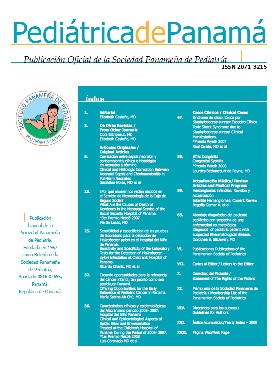Evaluation of risk factors and utility of a pediatric model predictive of progression to end stage renal disease in patients with chronic renal disease stages 2 to 4 attended at the Hospital del Niño Dr. José Renan Esquivel from 2007 to 2016
1,
1
Methods: A retrospective cohort study was conducted in which the records of patients with CKD and related diagnoses were reviewed of the Children’s Hospital Doctor Jose Renan Esquivel Nephrology Service, from the date of CKD diagnosis was settle down and then follow-up one year and 5 years from initial diagnosis in the period from January 2007 to December 2016.
Results: 33 patients entered the study. The median age was 6 years (SD +4). There were 18 female; 13 from the province of Panama. Univariate analysis was performed for risk factors, with a risk of progression to hyperphosphatemia at the first year of follow-up (RR = 6,750, p = 0.031) and 5 years of follow-up (RR = 3,857, p = 0.002); there was no statistical significance for the other variables studied. 13 progressed to CKD5. When applying the Oliveira pediatric predictive model of progression to CKD5, 11 were at low risk, 14 at medium risk and 8 at high risk at the admission to the study, obtaining a renal survival at 5 years of follow-up, 16 (76.1%), 2 (40%) and 2 (28.5%), respectively. The analysis of renal survival was not statistically significant.
Conclusions: Hyperphosphataemia in pediatric patients with CKD is associated with progression to CKD at the first year and 5 years of follow-up. Longitudinal, prospective and multicenter studies are needed to evaluate the utility of the pediatric predictive model of progression to CKD5.
Show Affiliation
Authors
DOI:
https://doi.org/10.37980/im.journal.rspp.20181618Keywords:
Chronic renal disease, risk factors for progression, pediatric predictive model of progression, end stage renaldiseaseAbstract
Introduction: The clinical course of chronic kidney disease (CKD) in the pediatric population is heterogeneous. The incidence of chronic kindey diseae stage 5 (CKD5) in the pediatric population has increased over the past two decades. The purpose of this study is to evaluate the risk factors and utility of a pediatric predictive model of progression to CKD5 in pediatric patients older than 2 years with chronic renal disease stage 2-4 treated at the Childrens Hospital Doctor Jose Renan Esquivel.Methods: A retrospective cohort study was conducted in which the records of patients with CKD and related diagnoses were reviewed of the Children’s Hospital Doctor Jose Renan Esquivel Nephrology Service, from the date of CKD diagnosis was settle down and then follow-up one year and 5 years from initial diagnosis in the period from January 2007 to December 2016.
Results: 33 patients entered the study. The median age was 6 years (SD +4). There were 18 female; 13 from the province of Panama. Univariate analysis was performed for risk factors, with a risk of progression to hyperphosphatemia at the first year of follow-up (RR = 6,750, p = 0.031) and 5 years of follow-up (RR = 3,857, p = 0.002); there was no statistical significance for the other variables studied. 13 progressed to CKD5. When applying the Oliveira pediatric predictive model of progression to CKD5, 11 were at low risk, 14 at medium risk and 8 at high risk at the admission to the study, obtaining a renal survival at 5 years of follow-up, 16 (76.1%), 2 (40%) and 2 (28.5%), respectively. The analysis of renal survival was not statistically significant.
Conclusions: Hyperphosphataemia in pediatric patients with CKD is associated with progression to CKD at the first year and 5 years of follow-up. Longitudinal, prospective and multicenter studies are needed to evaluate the utility of the pediatric predictive model of progression to CKD5.
Downloads
Published
2020-11-09
Issue
Section
Artículos originales
License
Copyright (c) 2020 Infomedic InternationalDerechos autoriales y de reproducibilidad. La Revista Pediátrica de Panamá es un ente académico, sin fines de lucro, que forma parte de la Sociedad Panameña de Pediatría. Sus publicaciones son de tipo gratuito, para uso individual y académico. El autor, al publicar en la Revista otorga sus derechos permanente para que su contenido sea editado por la Sociedad y distribuido Infomedic International bajo la Licencia de uso de distribución. Las polítcas de distribución dependerán del tipo de envío seleccionado por el autor.






